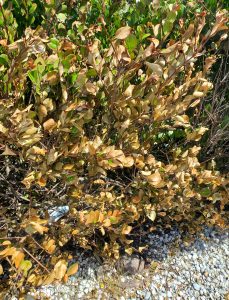
Each hurricane leaves its own signature on the landscape. Milton left us with widespread leaf scorch and saltwater inundation damage marring our once-beautiful landscapes. Things may look bad, but we can look to the future for some recovery and renewal.
The leaf scorch showing up in landscapes and natural areas appears to have been caused by high velocity wind that removed moisture from the plant tissue – some aerosolized salt damage and abrasion from small wind-blown particles could also have contributed. I used to work in a nursery, and when large plants were purchased – so large that they must be carried in the back of a truck or sticking out a window – we would carefully wrap them in burlap and lay them down for protection. Without this protection, the wind velocity generated by driving down the highway could remove the moisture from the leaves resulting in leaf scorch. The same can be experienced, but worst, with hurricane-force winds. While the optics are depressing, the plants should come back as they have plenty of reserves to help send out new leaves. It may be as in Ian where almost all of our plants suffered from total foliage lose. This was followed by an extra early spring with fresh new leaves.
Many landscape plants have varying degrees of salt-tolerance. For example, the black olive, frangipani, mahogany, live oak, and silver buttonwood, are considered salt tolerant. The mango, royal poinciana, and gumbo-limbo are categorized as moderately salt tolerant. High winds can move salt spray inland, coating plants with salt deposits. Salt causes water to move out of the plants resulting in desiccation. This water-lose is especially noticeable on young leaves where marginal scorch and leaf drop in non-salt-tolerant plants can be expected. Any salt-water inundation of landscape soil is best neutralized with freshwater flushes and/or rain events which will eventually leach out the salt. Salt damage recovery will depend on the individual plant and its particular salt tolerance. If your yard is very near the coast, this may be an opportunity to practice “Right Plant, Right Place”. This important concept is a Florida-Friendly Landscaping™ Principle where the thoughtful selection of salt-tolerant plants may help provide for a more sustainable yard moving forward.
Six-months from now you may look back at your formerly leaf-scorched landscape and try to remember how bad it looked. The wind-velocity damaged leaves will have fallen by then and been renewed by fresh growth. In a comparison, can you recall when freezes burned back foliage during our occasional cold snaps in the winter? By July, most of the damaged areas have been replaced by new abundant growth. As with a freeze, do not do any pruning now – allow the plants to recover and don’t add the stress of premature pruning. While you may be itching to clean up brown foliage, any pruning conducted now may stimulate additional new growth (there will be enough of that going on already) which will likely not be hardened off in preparation of any potential freezes or frosts this winter – be patient and wait until March for major pruning operations.
Despite all of the foliar browning and bronzing – and despite what caused it – we should recover just fine in time. Just look the other way for now, know that it is temporary for the most part, and keep planting! For more information on all subjects related to gardening in Southwest Florida, or to ask a question, you can also call the Master Gardener Volunteer Helpdesk on Mondays, Wednesdays, and Fridays from 1 to 4 pm at 764-4340 for gardening help and insight into their role as an Extension volunteer. Ralph E. Mitchell is the Director/Horticulture Agent for UF/IFAS Extension – Charlotte County. He can be reached at 941-764-4344 or ralph.mitchell@charlottecountyfl.gov. Connect with us on social media. Like us on Facebook @CharlotteCountyExtension and follow us on Instagram @ifascharco.
Resources:
Leonard-Mularz, M. (2022) Landscape Storm Recovery. The University of Florida Extension Service, IFAS – Monroe County.
Sanagorski, L. (2011) Wind Damage in the Landscape. The University of Florida Extension Service, IFAS – Palm Beach County.
Black, R. J. (2003) Salt-Tolerant Plants for Florida. The University of Florida Extension Service, IFAS.
The Florida-Friendly Landscaping™ Guide to Plant Selection & Landscape Design (2022) The University of Florida Extension Services, IFAS.
 1
1
